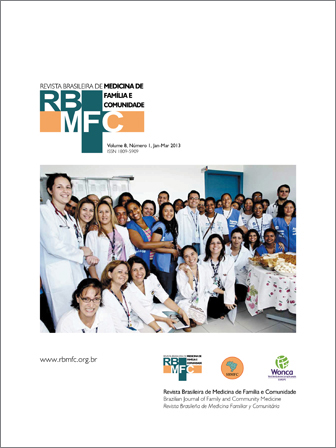Screening for breast cancer: the three traffic lights
DOI:
https://doi.org/10.5712/rbmfc8(26)677Keywords:
Breast Neoplasms, Mass Screening, Cost-Benefit Analysis, Quaternary PreventionAbstract
The interpretation of breast cancer screening as three different traffic lights invites the reader for a quick review of the scientific evidence and the retention of the main points that this procedure reveals. The recommendations for the screening are produced by authors that give a green light for the screening advance, because they believe that the risk/benefit balance is favorable to its application in women at the target ages and average risk. However, as the expression “risk/benefit” implies, there is a risk that must be taken into account at the time of starting the screening, which assumes an alert for the red light. It is clear, from the evidence evaluated by independent authors, that there is a balance of pros and cons (yellow light). The role of ensuring the balance of this scale belongs perhaps to the General Practitioner and the role of putting the last weight on one of the two plates belongs to the women at the target-ages to screening.
Downloads
Metrics
References
Independent UK Panel on Breast Cancer Screening. The benefits and harms of breast cancer screening: an independent review. Lancet. 2012; 380(9855): 1778-86. http://dx.doi.org/10.1016/S0140-6736(12)61611-0 DOI: https://doi.org/10.1016/S0140-6736(12)61611-0
Bull M, Schröder FH. Screening for prostate cancer – the controversy continues, but can it be resolved?. Acta Oncol. 2011; 50(Suppl 1): 4-11. http://dx.doi.org/10.3109/0284186X.2010.522197 DOI: https://doi.org/10.3109/0284186X.2010.522197
Welch HG, Black WC. Overdiagnosis in cancer. J Natl Cancer Inst. 2010; 102: 605-13. http://dx.doi.org/10.1093/jnci/djq099 DOI: https://doi.org/10.1093/jnci/djq099
Gérvas J. Abuso de la prevención clínica. El cribaje del cáncer de mama como ejemplo. Rev Espaço Saúde. 2009; 11: 49-53
Carlsson S, Vickers AJ, Roobol M, Eastham J, Scardino P, Lilja H et al. Prostate Cancer Screening: Facts, Statistics and Interpretation in Response to the US Preventive Services Task Force Review. J Clin Oncol. 2012; 21(30): 2581-84. http://dx.doi.org/10.1200/JCO.2011.40.4327 DOI: https://doi.org/10.1200/JCO.2011.40.4327
Moyer VA, U.S. Preventive Services Task Force. Screening for prostate cancer: U.S. Preventive Services Task Force Recommendation statement. Ann Intern Med. 2008; 149: 185-91 DOI: https://doi.org/10.7326/0003-4819-149-3-200808050-00008
Gotzsche PC, Hartling OJ, Nielsen M, Brodersen J. Screening for breast cancer with mamography. The Nordic Cochrane Centre; 2012. Disponível em: http://www.cochrane.dk/screening/mammography-leaflet.pdf.
Cancer Research UK. Predicted improvements in breast cancer survival. Disponível em: http://www.cancerresearchuk.org/cancer-help/about-cancer/cancer-questions/predicted-improvements-in-breast-cancer-survival
Brasil. Ministério da Saúde. Coordenação Nacional para as Doenças Oncológicas. Plano Nacional de Prevenção e Controlo das Doenças Oncológicas 2007-2010 Programa de desenvolvimento. Brasília: Ministério da Saúde, Alto Comissariado da Saúde; jul. 2009. Disponível em: http://www.portaldasaude.pt/NR/rdonlyres/F2CE0CE2-9802-473D-9F45-F375687EB4F0/0/pnpcdoversaofinal8julho2009.pdf
Brasil. Ministério da Saúde. Fortalecimento da rede de prevenção, diagnóstico e tratamento do câncer. Brasília: Governo Federal; 2011. Disponível em: http://portal.saude.gov.br/portal/arquivos/pdf/2b_060511.pdf
Instituto Nacional de Câncer. Parâmetros técnicos para o rastreamento do câncer de mama Recomendações para gestores estaduais e municipais. Brasília: Ministério da Saúde; 2009. Disponível em: http://www.acervo.epsjv.fiocruz.br/beb/textocompleto/009471
National Center for Health Promotion and Disease Prevention. Discussing breast Cancer screening decisions with average risk women in their 40’s. National Center for Health Promotion and Disease Prevention; 2011. Disponível em: http://www.prevention.va.gov/docs/VANCP_BreastCancerFact.pdf
Gotzsche PC, Nielsen M. Screening for breast cancer with mamography. Cochrane Database Syst Rev. 2011 Jan; (1):CD001877. http://dx.doi.org/10.1002/14651858.CD001877.pub4 DOI: https://doi.org/10.1002/14651858.CD001877.pub4
Nelson HD, Tyne K, Naik A, Bougatsos C, Chan BK, Humphrey L. Screening for breast cancer:an update foto the US Preventive Services Task Force. Ann Intern Med. 2009; 151: 727-737 DOI: https://doi.org/10.7326/0003-4819-151-10-200911170-00009
Thornton H, Pillariesetti RR. “Breast awareness” and “breast self-examination” are not the same. What do these terms mean? Why are they confused? Why can we do?. Eur J Cancer. 2008; 44(15): 2118-21. http://dx.doi.org/10.1016/j.ejca.2008.08.015 DOI: https://doi.org/10.1016/j.ejca.2008.08.015
ARS Norte. Circular Normativa no 1 Prescrição de mamografia de rastreio em mulheres do grupo erário dos 45 a 69 anos, nas unidades de cuidados de saúde primários. ARS Norte 2011. Disponível em: http://portal.arsnorte.min-saude.pt/portal/page/portal/ARSNorte/Documentos/Circulares%20da%20ARSNorte/Circulares%20Normativas%202011/Circular%20Normativa%201_2011.pdf
World Organization of Family Doctors - Wonca Europa. A definição europeia de Medicina Geral de Familiar. Wonca Europa; 2002. p. 6-14.
Downloads
Published
How to Cite
Issue
Section
License
By submitting a manuscript to the RBMFC, authors retain ownership of the copyright in the article, and authorize RBMFC to publish that manuscript under the Creative Commons Attribution 4.0 license and identify itself as the vehicle of its original publication.















